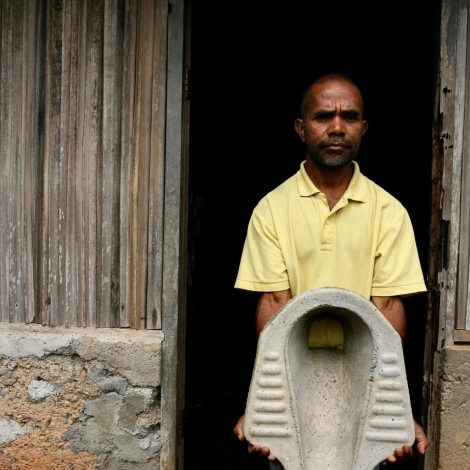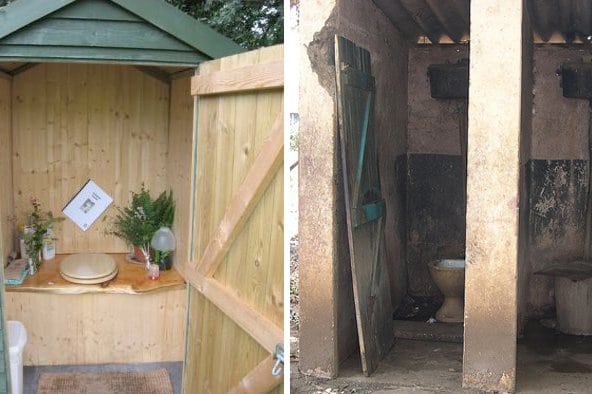Before we can change human behavior, we need to understand the human. Our recent research on sanitation successes in developing countries shows the sector needs a different way of thinking.
We know that about 68 percent of the world’s population has access to improved sanitation facilities, from a low of 7 percent in South Sudan to 100 percent in developed countries, according to the World Bank. But we don’t know how many people actually use these toilets, or whether they use them hygienically. And the little evidence that we do have suggests that many people don’t use a toilet even when one is available.
It seems obvious that toilets must be used to be effective. But only about 5 percent of the 180 studies and reports we found even reported on latrine use.
It seems obvious that toilets and latrines must be used to be effective in keeping feces out of the environment and preventing the spread of disease. But only about 5 percent of the 180 studies and reports we found even reported on latrine use. And when they did, it was usually reported at the household rather than individual level.
If we can learn why and how people use toilets, then we can think about improving the user experience, and thus increase hygienic use. The research we found suggests that regular, hygienic latrine use depends on these factors:
Differences within households
Surveys often assume one household respondent’s answer represents the activities of the whole household. But one study in India found that more than 40 percent of households with a working latrine have at least one member who defecates in the open (Coffey, et al., 2014).
Men or women
One study in Ethiopia showed differences between use by men, women, girls, and boys (Fry, et al., 2013). In India, women are more likely to use latrines than men (Odhiambo, 2015).
Young or old
Use of toilets by children and disposal of children’s feces is a particular area of concern. Many mothers believe children’s feces are harmless (Kathuni, 2015), and practice unsafe disposal even in households with access to improved sanitation facilities (Majorin, et al., 2014). For example, in Cambodia, only 20 percent of children’s feces were disposed of in an improved sanitation facility, according to the 2010 Demographic and Health Survey (Miller-Petrie, Voigt, McLennan, Cairncross, & Jenkins, 2015).
In fact, children’s feces may be more likely than adult’s to be contaminated with pathogens that cause diarrhea (Majorin, et al., 2014). Burying of child feces is especially common in sub-Saharan Africa and Southeast Asia. Disposal of child feces with garbage (e.g., in a diaper) is widely practiced in middle- and high-income countries and is becoming increasingly common in urban areas of low-income countries. An expert consultation on the safety of these two child feces disposal methods found almost unanimous agreement these should be considered neither safe nor improved (Bain & Luyendijk, 2015).
Where you go
Another study in Ethiopia found a distinct difference between how people use latrines at home and away from home. About 33 percent of adults practiced open defecation while based at home, but 77 percent practiced open defecation at a workplace (Tincani, Ross, Mujica, McIntosh, & Burr, 2015).
Religion and culture
Several studies have found that providing toilets does not ensure use when there are significant and culturally ingrained behavioral barriers to using latrines (Routray, Schmidt, Boisson, Clasen, & Jenkins, 2005). In yet another study in Ethiopia, cultural and religious reasons were given for why households did not have hand-washing facilities at the latrines (Tyndale-Biscoe, Bond, & Kidd, 2013).
Studies found that providing toilets does not ensure use when there are culturally ingrained behavioral barriers to using them.
In India, a survey of around 3200 households found that having a household latrine is widely seen to damage the purity of the home. Most Hindus are opposed to emptying their own latrine pits (Coffey, et al., 2014; Odhiambo, 2015). People from the lowest “untouchable” castes resist emptying latrine pits because this work is widely seen as degrading and reinforces their low social status (Coffey, et al., 2015). These factors can lead rural Indians to build latrines with very large pits that require emptying infrequently, if at all. In Nigeria, men might not want to share latrines with women and excretion is considered to compromise the purity of those with Voodoo powers (WaterAid, 2011). In parts of Eastern Africa, myths hold that men do not defecate, and that in-laws should not use the same site for defecation (Murigi, Stevens, Mwanzi, & Pasteur, 2015).
Dry or wet
In the Middle East, sanitation is primarily water-based; in the Jordan Valley, 97 percent of households – including the poorest – have installed their own pour-flush latrines. Dry sanitation would not be acceptable in this environment, or many other primarily Muslim settings (SANDEC, 2000). Customs and beliefs that have been enshrined in tribal life and societies of most West African countries affect technology choice, hygiene behaviors and the general institutional set up of actors (Awuah, 2009). WaterAid Nigeria found that “a low-quality toilet is an embarrassment for the family.” Instead, “people have a strong desire for an ‘ideal’ water-based toilet”, because it is easily cleaned, connected to modern urban life and aesthetically pleasing. But a water-based toilet is often too expensive, costing between 44 percent and 77 percent of an average family’s annual income.
Wiping vs. washing
Another reason why building toilets is not enough to lead to hygienic use is how people clean themselves after defecation. Some people wipe using paper or some other substance. Other people wash, using water and their hand. Thus, not only is a water supply is needed for cleaning and handwashing; but also possibly for flushing, anal cleansing (Tyndale-Biscoe, Bond, & Kidd, 2013) (Rosensweig, Perez, & Robinson, 2012).
Given the many human factors to consider when coming up with sanitation options that people can and will use, we need a new way of thinking. Design thinking combined with using the science of behavior change might be better ways forward than any infrastructure-focused approach.
Works Cited
Awuah, E. (2009). Sustainable Sanitation and Hygiene Delivery in West Africa. West Africa Regional Sanitaion & Hygiene Symposium. Accra, Ghana.
Bain, R., & Luyendijk, R. (2015). Are burial or disposal with garbage safe forms of child faeces disposal? An expert consultation. Waterlines, 34(3).
Coffey, D., Gupta, A., Hathi, P., Khurana, N., Srivastav, N., Vyas, S., & Spears, D. (2014). Open Defecation: Evidence from a New Survey in Rural North India. xlix(38).
Coffey, D., Gupta, A., Hathi, P., Spears, D., Srivastav, N., & Vyas, S. (2015). Culture and the health transition: Understanding sanitation behaviour in rural north India. International Growth Centre.
Colin, J. (2009). Sustainability and equity aspects of total sanitation programmes: A study of recent WaterAid-supported programmes in Bangladesh. WaterAid.
Ecopsis. (2013). Evaluation of the WASH Sector Strategy “Community Approaches to Total Sanitation” Sierra Leone FINAL VERSION (CATS). UNICEF.
Evans, B., Colin, J., Jones, H., & Robinson, A. (2009). Sustainability and equity aspects of total sanitation programmes: A study of recent WaterAid-supported programmes. Global Synthesis Report. WaterAid.
Fry, D., Freeman, M., Abaire, B., Feyisa, Y., Mideksa, D., Cunliffe, K., & Ambelu, A. (2013). Sustained Use, Utilization, and Diffusion of the Arborloo in Rural Ethiopia. Millennium Water Alliance Ethiopia Program.
Hanchett, S., Khan, M., Krieger, L., & Kullmann, C. (2011). Sustainability of sanitation in rural Bangladesh. Loughborough UK: 35th WEDC International Conference.
Hanchett, S., Krieger, L., Kahn, M., Kullmann, C., & Ahmed, R. (2011). Long-Term Sustainability of Improved Sanitation in Rural Bangladesh. WSP.
Kathuni, S. (2015, July 21). Sanitation Resolution Interview. (S. Davis, Interviewer)
Majorin, F., Freeman, M., Barnard, S., Routray, P., Boisson, S., & et al. (2014). Infant and Young Child Faeces Management: Potential enabling products for their hygienic collection, transport, and disposal in Cambodia. PLOS One 9(2): e89551.
Miller-Petrie, M., Voigt, L., McLennan, L., Cairncross, S., & Jenkins, M. (2015). Infant and Young Child Faeces Management: Potential enabling products for their hygienic collection, transport, and disposal in Cambodia. WaterSHED Asia.
Murigi, P., Stevens, L., Mwanzi, P., & Pasteur, K. (2015). Lessons Learnt in urban community-led total sanitation from Nakuru, Kenya. 38th WEDC International Conference. Loughborough, UK: WEDC.
Odhiambo, F. (2015, June 30). Sanitation resolution interview. (S. Davis, Interviewer)
Rosensweig, F., Perez, E., & Robinson, A. (2012). Policy and Sector Reform to Accelerate Access to Improved Rural Sanitation. Water and Sanitation Program.
Routray, P., Schmidt, W.-P., Boisson, S., Clasen, T., & Jenkins, M. (2005). Socio-cultural and behavioural factors constraining latrine adoption in rural coastal Odisha: an exploratory qualitative study. BMC Public Health, 15:880.
Ryan, P. (2014). Madagascar WASH Sector Sustainability Check. UNICEF.
SANDEC. (2000). Summary Report of Bellagio Expert Consultation on Environmental Sanitation in the 21st Century 1 – 4 February 2000. Duebendorf Switzerland: EAWAG.
Tincani, L., Ross, I., Mujica, A., McIntosh, K., & Burr, P. (2015). Improving VFM and sustainability in WASH programmes (VFM-WASH):Report of a WASH sustainability survey in Ethiopia. Oxford, UK: Oxford Policy Management.
Tyndale-Biscoe, P., Bond, M., & Kidd, R. (2013). ODF Sustainability Study. Plan International.
WaterAid. (2011). Revitalising Community-led Total Sanitation: A process guide.


The title of the article presumes that all human behavior across the board everywhere needs to be changed so that every single person in the world will be using a toilet, latrine, etc., 100% of the time. you might want to start by examining this presumption. i live part of the time in a rural village in west bengal, india. i can tell you why people do or don’t use toilets, and to what extent both using a toilet and not using a toilet both is and isn’t a problem. i can even tell you why people who didn’t have toilets then did have them stopped using them.
ok, tell us.
If you don’t mind, please tell us why!..